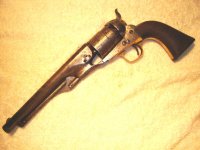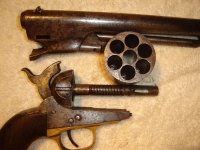Bill Akins
New member
I've been wondering about the question of how much stronger a previously open topped BP Colt would be if say someone welded a topstrap to the barrel and then milled so that the topstrap engaged the recoil shield and was locked in place like a topbreak's. Of course you couldn't tip the barrel down like a topbreak, so the rear of the topstrap's recess would have to be one that engaged the area of the recoil shield horizontally when the barrel slid on and then a recoil shield area stirrup pivoted over the topstrap to hold it securely. To take the barrel off, you'd just remove the wedge as normal, then pivot the spring loaded stirrup out of the way to slide the barrel off. Similar to a Webley or Iver Johnson stirrup etc....only without the barrel tipping down.
Now I know some of you may be thinking the Whitney revolver already has the topstrap like a Remy with the Colt style internals, but the difference here is that in my idea the barrel is removable where the Whitney is not.
Anyone ever heard of anyone experimenting with an idea like this? And if so, did it improve the strength of the BP revolver so that heavier loads could be more safely used without harming the previously open topped revolver?
.
Now I know some of you may be thinking the Whitney revolver already has the topstrap like a Remy with the Colt style internals, but the difference here is that in my idea the barrel is removable where the Whitney is not.
Anyone ever heard of anyone experimenting with an idea like this? And if so, did it improve the strength of the BP revolver so that heavier loads could be more safely used without harming the previously open topped revolver?
.
Last edited:



